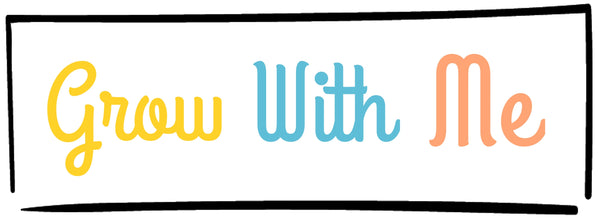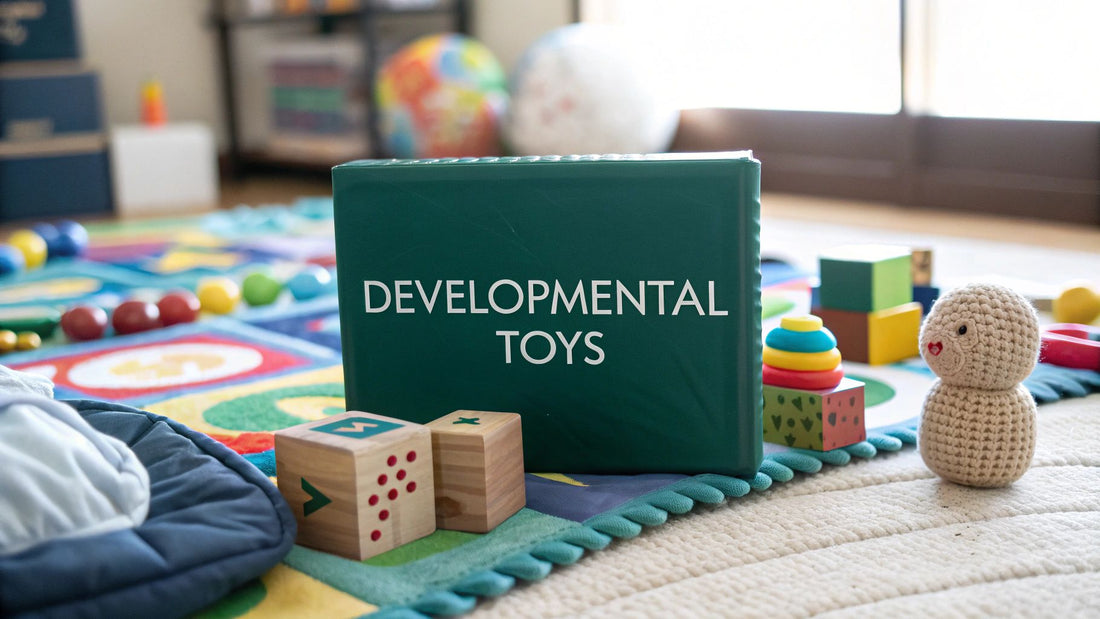
A Guide to Developmental Toys for Infants
Share
You might hear the term "developmental toy" and wonder what makes it different from any other toy in the nursery. At its heart, a developmental toy is simply a tool designed with a baby's growth in mind. Think of it less as a plaything and more as the very first educational material your child will encounter, crafted to support them on their incredible journey of discovery during that first year.
Why Developmental Toys Matter for Your Baby
When you watch a baby completely absorbed by a colourful rattle or determinedly reaching for a soft, crinkly book, you're seeing learning in action. For an infant, play isn't just about passing the time; it's how they make sense of the world around them. Developmental toys are designed to supercharge this natural process, helping to build vital neural connections in their rapidly growing brain.
These toys act almost like a guide for your baby's first year. Instead of just being a distraction, they’re chosen to target the specific skills that are just beginning to emerge at each new stage. It’s this focus that makes playtime not just fun, but incredibly productive for their growth.
The Core Benefits of Purposeful Play
Bringing developmental toys into your baby’s daily routine helps build a solid foundation for all their future learning. Unlike toys that just aim to entertain, these are created with specific goals.
- Awakening the Senses: Toys with different textures, gentle sounds, and bold, high-contrast colours help a baby’s senses come alive. This sensory input is crucial for them to begin processing and organising information about their environment.
- Building Motor Skills: From the tiny, determined grasp of a wooden ring to the bigger effort of pushing a soft ball, these toys encourage both fine motor skills (small hand movements) and gross motor skills (larger movements like crawling).
- Boosting Brain Power: Simple activities like stacking cups or trying to fit a shape into the right hole are a baby's first lessons in cause-and-effect, problem-solving, and understanding how objects relate to each other in space.
The big idea is straightforward: Play is how babies learn. Developmental toys are the tools that make this learning more effective and enriching, turning everyday moments into powerful opportunities for growth.
This shift in understanding isn't just happening in parenting circles; it's clear in the market, too. In the United Kingdom, the demand for toys that support early development is surging. The UK baby toys market was valued at around USD 821.5 million and is expected to almost double by 2035.
This trend shows just how much parents today want to give their little ones the best possible start. If you're interested in the numbers, you can explore more data on UK baby toy market trends from Market Research Future.
How Play Shapes Your Baby's Developing Brain
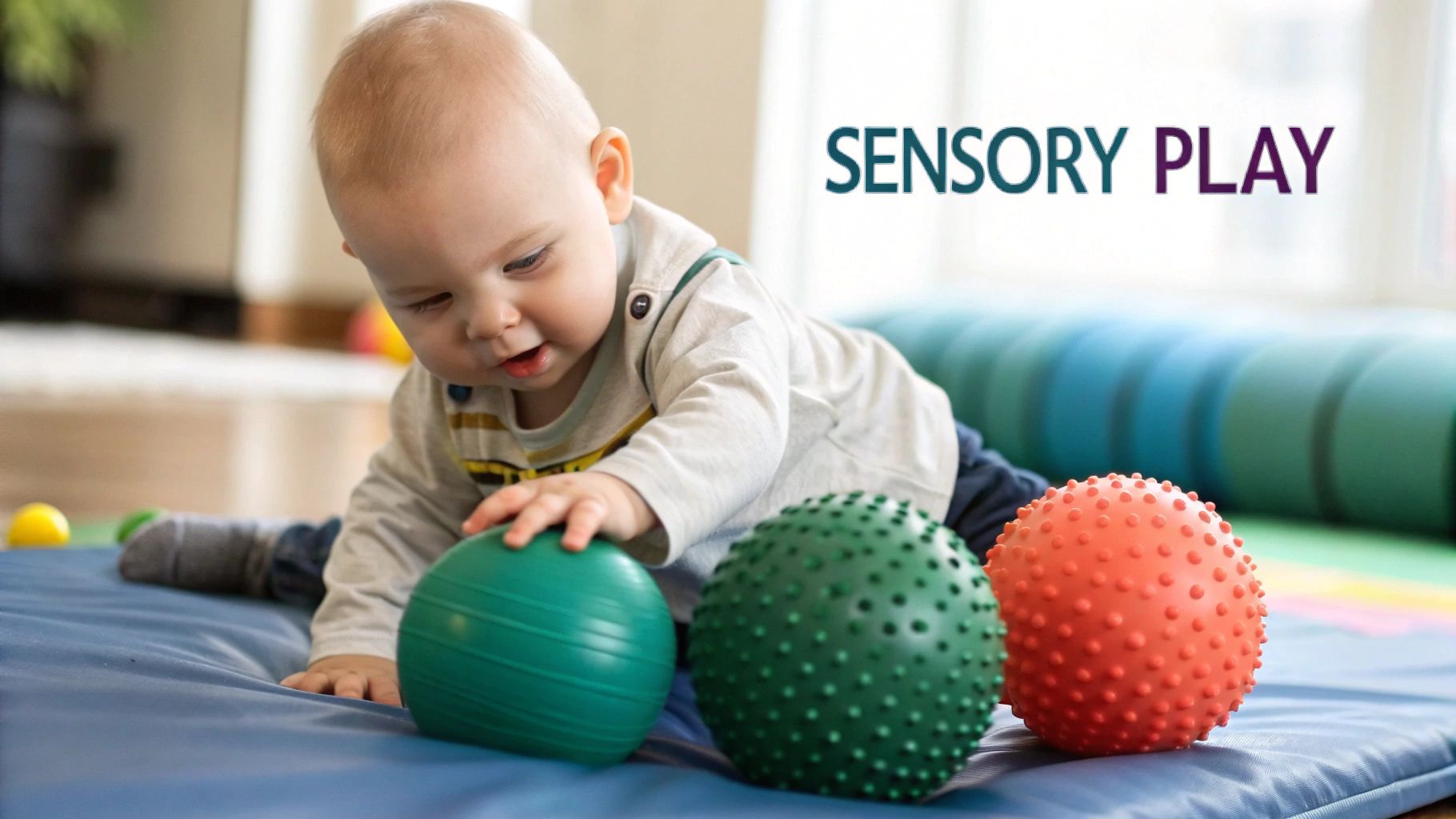
From their very first day, babies are like tiny explorers, constantly gathering data to figure out how the world works. Their brain is developing at a pace it never will again, forging more than a million new neural connections every single second. This incredible growth doesn't just happen automatically; it’s powered by experience. And for a baby, the most powerful experience is play.
This is where developmental toys come in. Think of them less as simple amusements and more as the tools of your baby’s trade. They are specifically designed to build the architecture of a growing brain, strengthening pathways that will last a lifetime. When your little one is rattling a toy or stacking a block, it’s not just a moment of fun—it's a full-on brain workout.
Cognitive Development: Your Baby's First Puzzles
Cognitive skills boil down to thinking, learning, and solving problems. For an infant, this journey starts with the simple magic of cause and effect. Take a basic rattle: when a baby shakes it, it makes a noise. That connection—"I did something, and it made that happen!"—is a monumental cognitive leap.
It's like they're solving their very first puzzle. Toys like nesting cups or simple shape sorters build on this discovery, encouraging them to experiment. They start to figure out which block fits into which hole, learning about the relationships between different objects. Every success, no matter how small, reinforces these new mental pathways.
Motor Skills: Training for Future Coordination
Motor skills fall into two key camps, and the right toys are brilliant for helping develop both.
- Gross Motor Skills: These are the big movements using large muscle groups—the skills needed for rolling over, sitting up, and eventually walking. An activity gym is a perfect example, encouraging your baby to reach, kick, and wiggle, which strengthens their core, legs, and arms.
- Fine Motor Skills: These involve all the small, precise movements of the hands and fingers. Grasping a chunky wooden ring or fumbling to turn the page of a soft book is crucial practice. You can think of it as the foundational training for one day holding a crayon or using a spoon.
Every single one of these physical actions sends a constant stream of feedback to the brain, helping it fine-tune coordination and control.
The Big Picture: Every interaction with a well-chosen toy is a conversation between your baby’s body and their brain. This "conversation" builds the pathways needed for everything from writing their name to kicking a football.
Sensory Exploration: Learning Through Touch, Sight, and Sound
A baby’s senses are their primary channels for learning. A simple textured ball isn't just something to hold; it's a rich sensory lesson. The different bumps and ridges send unique signals to the brain, helping it learn to file away and understand different textures.
This is why sensory play is so fundamental. It’s how babies discover the properties of the world around them. The best developmental toys often include a mix of elements to stimulate these senses:
- Textures: Smooth wood, soft fabrics, and bumpy silicone all provide different kinds of information.
- Sounds: Gentle rattles, crinkling materials, and soft jingles teach them to distinguish between different sounds.
- Sights: For newborns, high-contrast black and white patterns are ideal for stimulating their developing vision.
Through these experiences, a baby’s brain gets better at processing and organising the constant flow of information coming in from its senses—a skill essential for absolutely all future learning.
Social and Emotional Foundations: Building Bonds Through Play
Play is rarely a solo mission; it's deeply social. In fact, the most important "toy" your baby will ever have is you. When you use a hand puppet to "talk" to your baby or roll a soft ball back and forth, you’re teaching the absolute fundamentals of human interaction.
These shared moments are how crucial emotional skills are built. Your baby learns about taking turns, reading your facial expressions, and understanding emotional cues. Your engagement transforms a simple object into a tool for connection, laying the groundwork for empathy, communication, and building healthy relationships down the line.
Choosing the Best Toys for Each Age and Stage
Picking out the right developmental toys for an infant can feel like you’re trying to hit a moving target. Just when you think you’ve cracked the code on what grabs their attention, they grow, change, and are suddenly hungry for a new challenge. It’s all about matching the toy to their specific developmental stage—giving them just the right amount of stimulation without it being frustrating or, just as bad, boring.
Think of it like buying a pair of shoes. If they're too small, they'll pinch and be no fun at all. Too big, and they're just clumsy and impossible to use. A well-chosen toy fits your baby’s current abilities perfectly, supporting the exact skills they’re working so hard to master in that moment.
Let’s break down the incredible first year into four key phases, looking at the milestones your baby is reaching and the perfect toys to cheer them on.
The First Three Months: The Sensory Awakener
During those first few months (0-3 months), a baby’s world is a whirlwind of new sensory information. Their vision is still coming into focus, which is why high-contrast images are so captivating. They can't see the full spectrum of colours yet, so bold black-and-white patterns are incredibly stimulating for their developing eyes.
Right now, their main job is simply to take in the sights, sounds, and textures of their new surroundings. Their movements are mostly reflexive, but they're slowly gaining control, beginning to track objects with their eyes and react to interesting sounds.
Key Milestones at 0-3 Months:
- Focusing on faces and high-contrast patterns.
- Starting to follow moving objects with their eyes.
- Reacting to loud or surprising sounds.
- Beginning to lift their head during tummy time.
Toy Recommendations for Newborns:
- High-Contrast Flash Cards: Simple black-and-white cards or soft books are a feast for their developing eyes.
- Soft Rattles and Wrist Shakers: These are brilliant for teaching cause and effect—"when I move my arm, it makes a sound!"
- Play Gyms with Dangling Toys: This encourages them to reach and kick, building those crucial early gross motor skills.
- Unbreakable Mirrors: Babies are utterly fascinated by faces, especially their own. It’s an early lesson in self-awareness.
Four to Six Months: The Skill Builder
This stage (4-6 months) is all about discovery through action. Your baby is turning into a little scientist, intentionally grabbing, shaking, and—of course—mouthing everything they can get their hands on. This is precisely how they learn about different shapes, textures, and what things do.
Their motor skills are taking off. They’re gaining much better control of their hands and are probably rolling over and pushing up on their arms. It’s a huge time for building the strength and coordination they’ll soon need for sitting and crawling.
This infographic shows just how much is going on behind the scenes with their motor development.
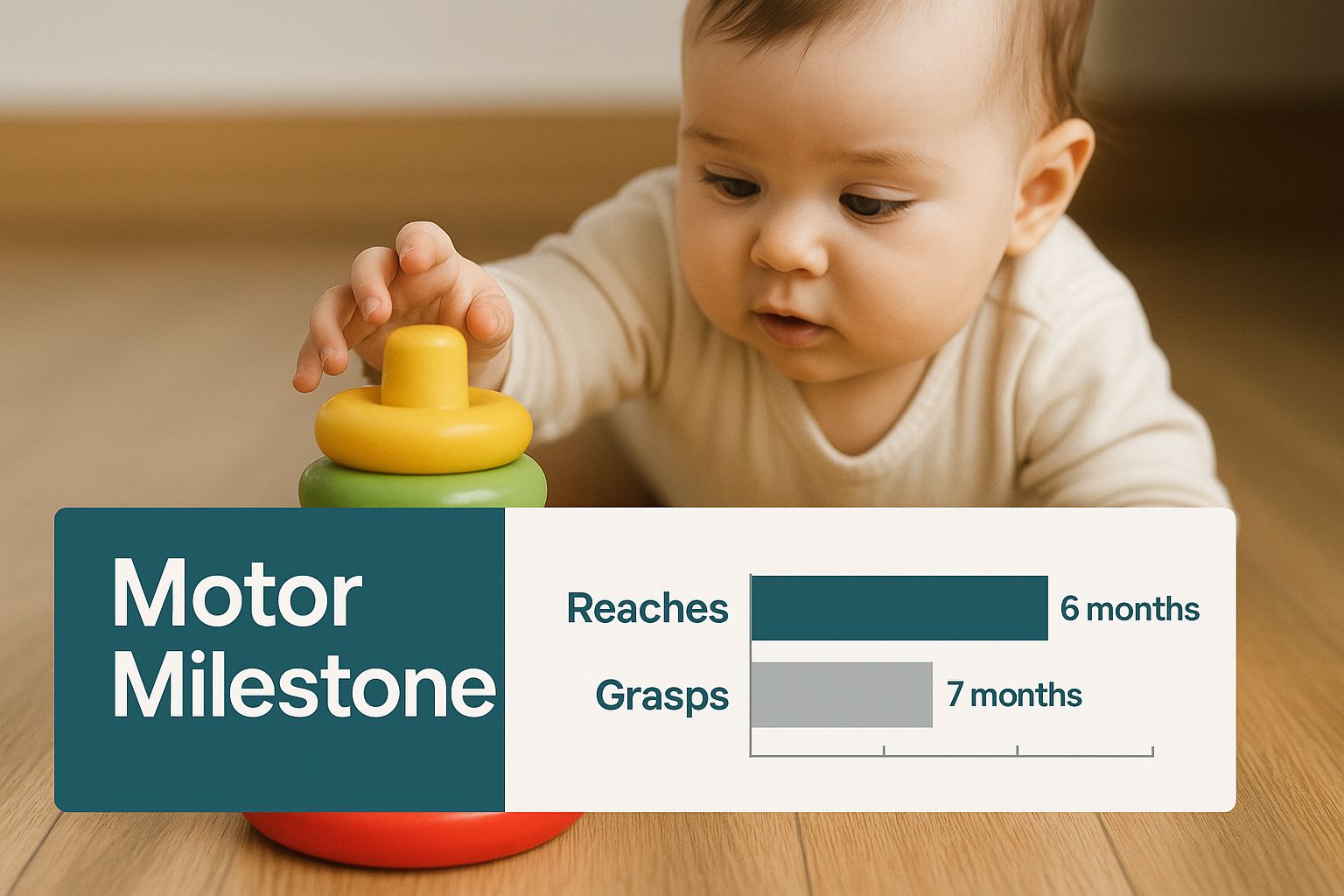
It’s a great reminder that a simple action, like reaching for a toy, is actually a complex exercise in developing motor control and hand-eye coordination.
Toy Recommendations for 4-6 Months:
- Teething Toys: Look for ones made from food-grade silicone or natural rubber that are easy to hold and safe to chew on.
- Soft, Crinkly Books: These books are a sensory party, full of different textures to feel and sounds to make.
- Activity Centres: They offer a safe spot for your baby to practise standing and bouncing while playing with lots of attached toys.
- O-Balls and Textured Balls: Their lightweight, easy-to-grasp design is perfect for developing hand strength and coordination.
Seven to Nine Months: The Little Explorer
Welcome to the age of mobility (7-9 months)! Many babies are now sitting up on their own, crawling, or even pulling themselves up to stand. Their world has suddenly expanded, and they are off to explore every single corner of it.
On the cognitive front, they’re starting to grasp object permanence—the amazing idea that something still exists even when they can’t see it. This is why a game of peek-a-boo is suddenly the most hilarious thing in the world. They’re also mastering their pincer grasp, using their thumb and forefinger to pick up smaller treasures.
At this stage, toys that encourage movement and problem-solving are perfect. You're no longer just bringing the world to them; you're giving them the tools to go out and explore it for themselves.
Toy Recommendations for 7-9 Months:
- Stacking Rings and Cups: These classics are fantastic for developing fine motor skills and understanding concepts like size and order.
- Shape Sorters: A simple shape sorter is an excellent introduction to problem-solving and helps with shape recognition.
- Soft Blocks: Perfect for stacking high and knocking down, which teaches cause and effect in the most satisfying way possible.
- Push-and-Pull Toys: Once they’re mobile, toys they can push or pull along give them a great reason to keep moving and work on coordination.
- Sensory Balls: Balls with different textures, bumps, and nubs continue to provide valuable sensory input. For more inspiration, check out our in-depth look at the benefits of sensory toys for babies.
Ten to Twelve Months: The Emerging Problem-Solver
As your baby closes in on their first birthday (10-12 months), their play becomes much more purposeful. They aren't just banging blocks together anymore; they're genuinely trying to build with them. They are shifting from simple exploration to active problem-solving.
Their fine motor skills are becoming much more refined, letting them handle objects with greater precision. This is the perfect time to introduce toys that require a bit more thought and dexterity, laying the groundwork for more complex play as they enter toddlerhood.
To make things a bit easier, here’s a quick-reference table matching each stage with the best toys.
Infant Developmental Milestones and Toy Guide (0-12 Months)
| Age Range | Key Developmental Milestones | Recommended Toy Types | Examples |
|---|---|---|---|
| 0-3 Months | Developing vision, tracking objects, reflexive movements | High-Contrast, Sensory | Black-and-white cards, soft rattles, play gyms |
| 4-6 Months | Reaching, grasping, mouthing, rolling over | Teethers, Grab-and-Shake Toys | Silicone teethers, O-balls, crinkly books |
| 7-9 Months | Sitting, crawling, understanding object permanence | Stacking, Sorting, Cause-and-Effect | Stacking rings, shape sorters, push toys |
| 10-12 Months | Pulling to stand, cruising, imitating actions | Simple Puzzles, Building Toys | Chunky wooden puzzles, large building blocks, toy phones |
This table can be a handy guide when you're choosing the next toy to support your little one's amazing journey of discovery.
Toy Recommendations for 10-12 Months:
- Chunky Wooden Puzzles: Simple puzzles with big knobs are wonderful for developing fine motor skills and spatial awareness.
- Large Building Blocks: These encourage creativity and introduce the most basic engineering concepts (what topples and what doesn't!).
- Toy Phones or Remote Controls: Babies this age absolutely love to imitate adults, and these toys let them do it safely.
- Ride-On Toys: A great way to build balance and strengthen leg muscles as they get ready for those first steps.
Building a Well-Rounded Toy Collection
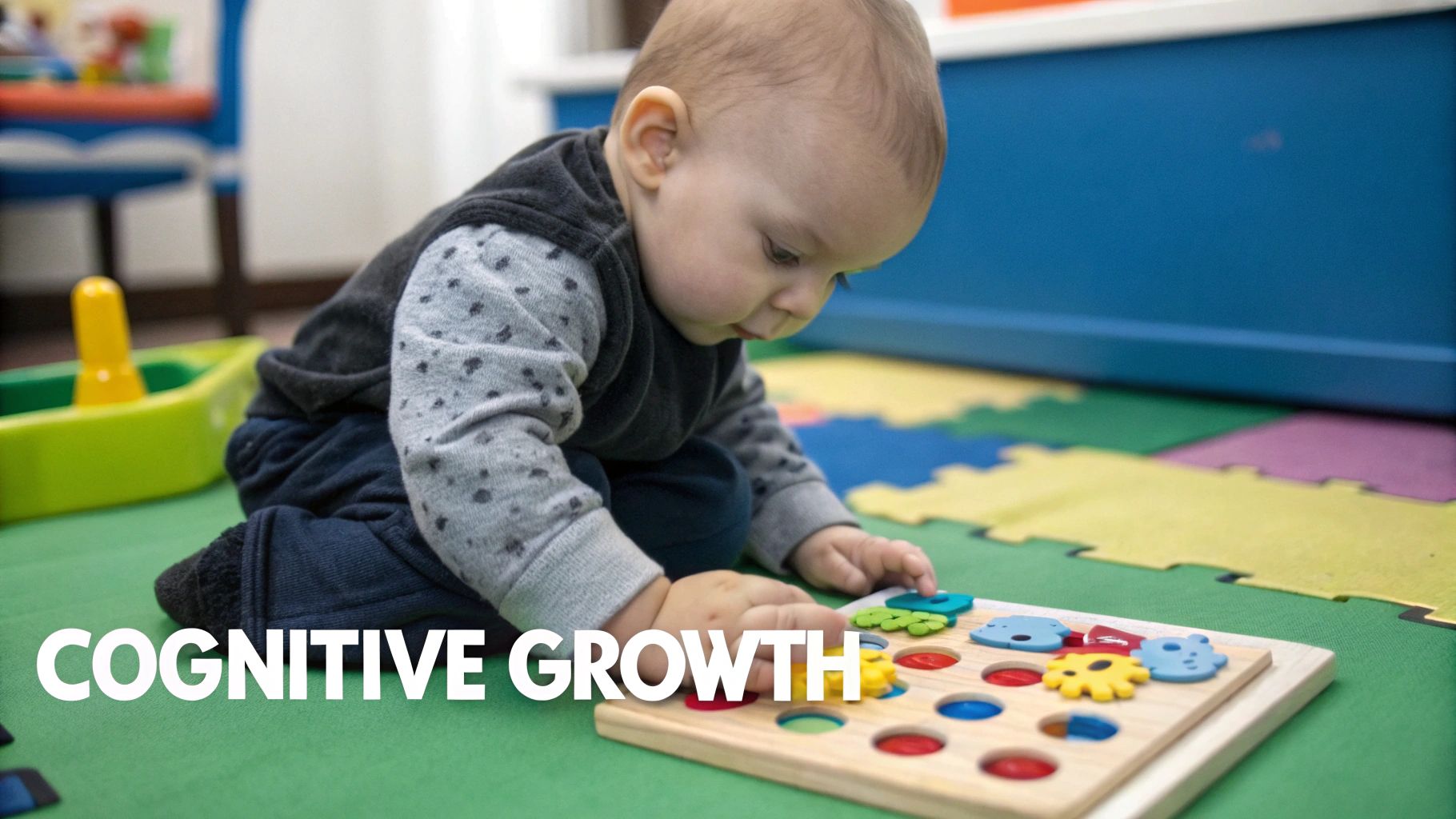
While it's helpful to know what milestones your baby is working towards, creating a fantastic collection of developmental toys goes beyond just matching the age on the box. Instead of grabbing something just because it says "6-months-plus", think of yourself as a curator for your little one's first learning experiences. You're choosing tools that will nourish different, equally important areas of their growth.
Think of it like planning a healthy diet; your baby needs a bit of everything to thrive. A toy box filled only with stacking rings is the playtime equivalent of serving only carrots for every meal. To nurture their whole development, it's about creating a varied ‘play diet’ that stimulates all their emerging skills at once.
This really comes down to organising your collection around four key pillars: sensory exploration, motor skills, logic, and early language. When you have toys from each of these categories, you're building a rich environment where your baby can always find something that fits what their brain and body are ready to learn next.
Sensory Exploration Toys
Sensory toys are your baby’s first real introduction to the world around them. They’re designed to fire up the senses of touch, sight, and sound, helping your infant’s brain learn to sort through and make sense of new information. These toys are the absolute foundation of learning, teaching your baby about different textures, sounds, and colours.
You can think of these as the 'data collectors' for a developing mind. Every crinkle, rattle, and soft texture is a new piece of information that helps build a more detailed map of the world.
- What they nurture: Sensory processing, fine motor skills, and an early grasp of cause-and-effect.
- Examples: Textured balls, crinkle books, soft rattles with gentle sounds, and high-contrast fabric squares.
Motor Skill Development Toys
This category is all about getting moving. Motor skill toys encourage your baby to use their muscles, from the large ones needed for kicking and crawling (gross motor skills) to the tiny, precise ones in their hands and fingers (fine motor skills). An activity gym gets them to reach and kick, while a simple wooden ring is a perfect tool for practising their grasp.
These toys are essentially the gym equipment for your baby's physical development. They strengthen their core, improve coordination, and build the physical confidence they need for big milestones like sitting up, crawling, and eventually walking.
A great toy collection supports both the big, whole-body movements and the small, fiddly ones. This balance is crucial for developing the physical control needed for everything from rolling over to picking up a tiny piece of food.
Logic and Problem-Solving Toys
Long before they’ll ever tackle a maths problem, your baby is already building the foundations of logic. These toys introduce the earliest concepts of problem-solving, spatial awareness, and cause and effect. That moment an infant finally figures out that only the square block fits into the square hole? That’s a huge cognitive leap.
This category includes many of the classic developmental toys for infants for good reason; they offer satisfying little challenges that build critical thinking skills for life.
- What they nurture: Problem-solving, hand-eye coordination, and an understanding of how objects relate to each other (like size and shape).
- Examples: Stacking rings, nesting cups, simple shape sorters, and chunky wooden puzzles with big, easy-to-grab knobs.
Early Language and Social Toys
Language doesn’t start with the first word—it begins much earlier with listening, watching, and interacting. Toys in this category are all about making that interaction happen, giving you a reason to talk, sing, and tell stories to your baby. They help build the social and emotional foundations on which all communication is built.
Essentially, these toys are props for conversation. A simple puppet becomes a character with a funny voice, and a picture book opens up a whole world of new sounds and words. This growing awareness among parents is reflected across the UK, where total toy sales have hit USD 3.91 billion. The market for children under five is set to grow at a rate of 4.5% per year, and you can review expert analysis of the UK toys market to learn more about this trend.
Putting Safety First with Every Toy You Choose
When you're building up your baby's collection of developmental toys, nothing matters more than safety. It’s easy to get caught up in the bright colours and exciting sounds, but your most important job is to be a bit of a safety inspector. Every toy that comes into your home should be a source of fun and learning, never a reason to worry.
The good news is, checking for toy safety is more straightforward than it sounds. Here in the UK, a couple of key markings on the packaging are your first line of defence. They're a clear signal that a toy has passed strict safety tests, so learning to spot them will help you choose with confidence.
Keep an eye out for the CE and UKCA marks. When you see these on a toy, it means the manufacturer is officially stating that it meets all the essential health and safety rules required by UK law. Think of it as a passport that proves the toy is safe and legal to sell.
Decoding Materials and Avoiding Harmful Substances
Beyond the official stamps of approval, the actual materials a toy is made from are crucial. Babies explore everything with their mouths, so it’s vital that anything they’re gumming or chewing on is non-toxic.
When you're picking out toys, especially anything that looks like it will get a good chew, always look for high-quality, baby-safe materials.
- Food-Grade Silicone: This is a fantastic choice for teethers and sensory balls. It’s tough, easy to clean, and free from nasty chemicals like BPA.
- Natural Wood: Whether it's unfinished or sealed with a non-toxic, water-based paint, wood is a classic, safe, and wonderfully sensory option.
- 100% Natural Rubber: Sourced from the Hevea tree, this is a popular, sustainable material for teethers and bath toys.
Just as important is knowing what to steer clear of. Always double-check labels to make sure toys are free from Bisphenol A (BPA), phthalates, and lead. These chemicals have been linked to health issues and simply don’t belong anywhere near your baby. If you'd like some more ideas, our guide to the best teething toys for babies dives deeper into safe materials.
Practical Checks for Everyday Safety
Your safety checks shouldn't end the moment you get a toy home. It's so important to give toys a quick once-over every now and then to make sure they're still in good shape.
A toy that was perfectly safe when new can become a hazard through normal wear and tear. A quick, routine inspection before playtime is one of the most effective safety habits you can build.
Try working these simple checks into your routine:
- The Toilet Roll Test: This is a brilliant, no-fuss way to spot a choking hazard. If a toy—or any bit that could break off—can fit completely inside a standard toilet roll tube, it’s too small for a child under three.
- Inspect for Damage: Give toys a regular once-over. Look for splintered wood, cracked plastic, or any peeling paint. If you spot any damage, it's best to repair it straight away or get rid of the toy.
- Secure Seams and Attachments: For soft toys, check that the seams are still holding strong. Tug gently on any buttons, eyes, or noses to make sure they're securely attached and can't be pulled off.
- Check Battery Compartments: If a toy uses batteries, make sure the battery cover is screwed on tightly. This prevents little fingers from getting to the batteries, which are a serious hazard if swallowed.
Weaving Play into Your Everyday Routines
You don't need to block out hours for structured activities to make a difference. In fact, some of the most powerful learning happens in the small, everyday moments you already share with your baby. By weaving play into your daily routines, you can turn ordinary tasks into incredible opportunities for growth.
Take nappy changes, for instance. Instead of rushing through them, try gently stroking your baby’s feet with a soft, silky scarf, then with a slightly rougher muslin cloth. This simple act is a sensory lesson, teaching their brain to distinguish between different textures. Just like that, a mundane moment becomes a meaningful connection.
Finding Play in Unexpected Places
Your daily life is packed with chances to engage your baby's developing mind. The secret is to see the world through their eyes—as a place full of new sounds, sights, and sensations just waiting to be discovered.
- Meal Times: As you prepare their food, talk them through it. Describe the bright orange of the carrot purée or the smooth texture of the yoghurt. This builds crucial language skills long before they can say a word.
- Laundry Day: Let your baby safely touch different fabrics as you fold clothes. The contrast between a soft fleece jumper and a crisp cotton sheet is a fantastic sensory experience.
- Bath Time Fun: A simple plastic cup can be the best toy in the world. Pouring water and watching it splash teaches the fundamental concept of cause and effect in the most enjoyable way possible.
Remember, you are your baby's first and most important 'toy'. Your voice, your touch, and your attention are the most powerful tools you have for nurturing their development.
Keeping Playtime Fresh and Engaging
To keep your little one curious, it helps to create an environment that sparks their interest. One of the best ways to do this is with toy rotation. Instead of having every toy out at once, just keep a small selection available and swap them out every week or so. When a toy reappears after a little break, it feels brand new and exciting all over again.
It's also a great idea to create a "yes space"—a safe, baby-proofed area where your little one is free to explore without you constantly saying "no." This freedom is brilliant for building their confidence and encouraging independent curiosity. For more ideas on simple yet effective learning moments, explore our guide on developmental activities for infants.
The market for these enriching tools is booming, with the UK's activity and developmental toys sector estimated at USD 3.7 billion and set to grow by 6% annually. You can discover more insights about the global infants toy market from GMI Insights to see how this trend is expanding. Ultimately, though, it’s your loving interaction that turns a simple object into a valuable learning tool.
Your Questions About Infant Toys Answered
Stepping into the world of infant toys can feel a little overwhelming, and it's natural to have questions. Let's tackle some of the most common ones I hear from parents, giving you the confidence to pick the perfect playthings for your little one.
How Many Toys Does My Baby Really Need?
It’s so easy to get carried away and fill the nursery with every colourful, noisy toy you see. But honestly, when it comes to your baby's development, less is more. The real aim here is quality over quantity. Too many choices can actually overstimulate a baby, making it hard for them to focus and play properly.
A great starting point is a small, carefully chosen collection of around 8-10 high-quality toys. Think about covering the main bases: something for their senses, something for motor skills, and something that gets their little brain ticking. You can then rotate these toys every week or so to keep things interesting without creating chaos.
Focus on a handful of purposeful items rather than a mountain of plastic. A few well-chosen toys that grow with your baby offer far more value than a room full of clutter.
Are More Expensive Toys Actually Better?
A hefty price tag doesn't always equal a better toy. In fact, it's often the simplest, most open-ended toys—like a set of wooden blocks or basic stacking cups—that offer the biggest developmental punch. Why? Because they invite your child to use their own imagination.
Some of the pricier electronic toys can end up being quite passive, where the toy does all the work. The best developmental toys for infants are the ones that encourage your baby to be an active participant. Instead of focusing on price, look for quality materials like natural wood or food-grade silicone. They might cost a little more upfront, but their durability and safety make them a worthwhile investment.
How Do I Clean and Care for Different Toys?
With everything ending up in your baby’s mouth, keeping toys clean is non-negotiable. It's not as much of a chore as it sounds, but different materials need different care.
- Wooden Toys: The golden rule is never to soak them. A quick wipe-down with a damp cloth and a mild mix of water and vinegar works perfectly. Just let them air-dry completely afterwards.
- Fabric and Soft Toys: Always check the care label first. Most can be popped into a mesh laundry bag and run through a gentle wash cycle.
- Silicone and Plastic Toys: These are usually the easiest to handle. You can wash them in warm, soapy water or, even better, place them on the top rack of your dishwasher.
At Grow With Me, we take the guesswork out of finding the perfect toys. Our curated subscription boxes deliver age-appropriate, high-quality developmental toys right to your door. Explore our stage-based play kits and start your journey today!
